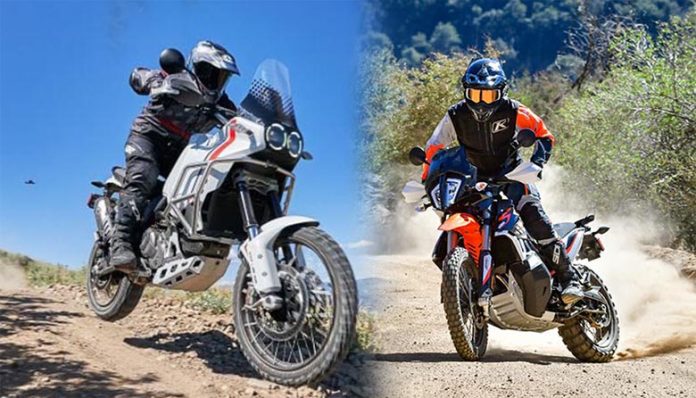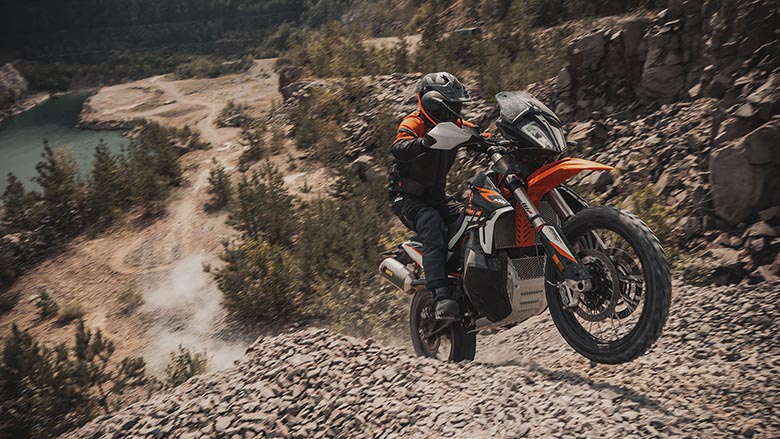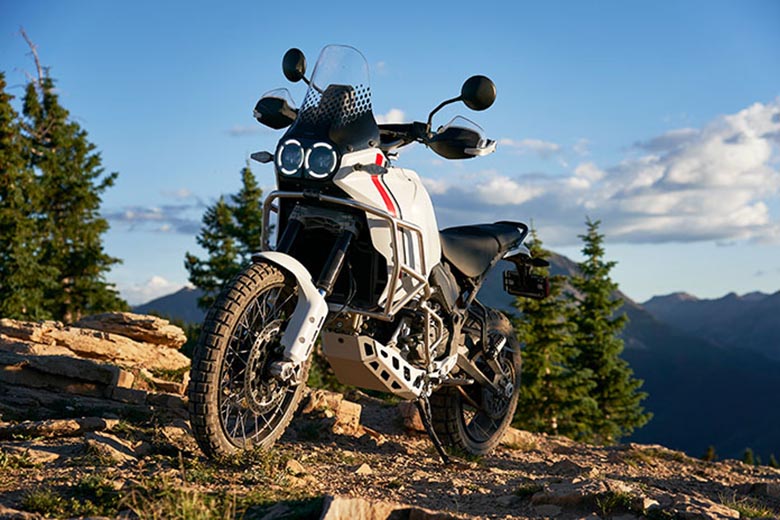Today’s article deals with the comparison review of DesertX Ducati vs 890 Adventure R KTM. The Ducati DesertX is a powerful new competitor in the midsize ADV market. How does it compare to the KTM 890 Adventure R, the reigning class king? With the 790/890 Adventure series, KTM has known this for a while, as has Triumph with the Tiger 850 and BMW with the 750/850 GS range.
The DesertX wasn’t a fabricated scrambler like the prototype we saw in 2019 at EICMA; instead, it was built from the ground up with serious sports adventure riding in mind. When the 890 Adventure R from KTM, the northern Austrian neighbors, was out, Ducati had one particular bike in mind that it aimed to knock off. The following is the comparison review of the DesertX Ducati vs 890 Adventure R KTM.
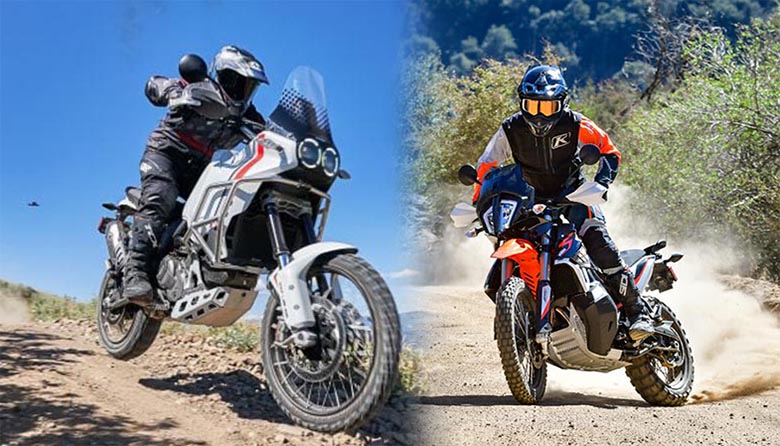
DesertX Ducati vs 890 Adventure R KTM – Features Comparison
Pricing
The first one is cost. The Ducati costs $17,095, which is 8.7 percent higher than the KTM‘s $14,199 price. That’s a considerable amount of money, but with the Ducati, you can only get one specific motorcycle model. It provides you with the 11° Testastretta L-110 twin’s horsepower and 68 lb-ft of torque, a tubular steel chassis, KYB suspension, and all the electronic bells and whistles, like cruise control, full LED lighting, six riding modes, four power modes, Ducati Wheelie Control (DWC), Engine Brake Control (EBC), cornering ABS with off-road mode, Daylight Position Lamp (DRL), Ducati Brake Light (DBL that flashes for emergency stops), USB power socket, 12V socket and self-canceling indicators.
Also Read: 2023 Ducati Multistrada V4 S vs 2023 BMW R 1250 GS
The KTM follows the practice of gradually upgrading specifications after purchase. The Rally Pack, which costs an additional $500, unlocks nine-stage adjustable traction control in addition to the KTM’s conventional on/off traction control and adds the Rally throttle mode to go with the Street, Off-Road, and Rain modes.
Additionally, KTM has Motor Slip Regulation, which works with the slipper clutch and slowly opens the throttle valves to provide a more controlled deceleration if the throttle is cranked hard or the grip level is low, as can be the case when riding a trail.
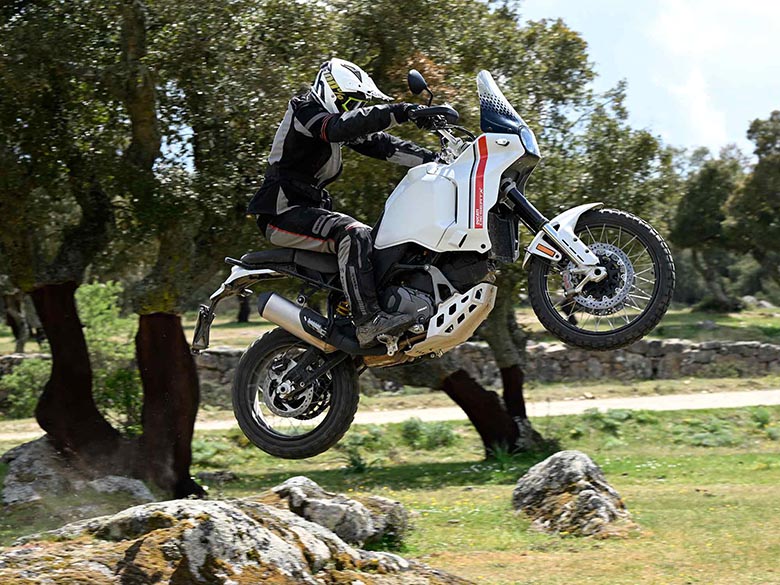
Additionally, the KTM has a loud 889cc parallel-twin engine that produces 100 horsepower and 74 lb-ft of torque, a tubular steel chassis with the fuel tank mounted low and close to the rider’s knees, a 12V power socket, cruise control, and 0.74 inches more rear suspension travel at 9.4 inches (as opposed to 9.06 inches on the Ducati’s front suspension).
Not Same, Same
One of the critical distinctions between the two bikes can be seen when examining the spec sheet in more detail. The Ducati has far more relaxed dimensions than the KTM, which has a 60.2-inch wheelbase, a steering rake of 26.3 degrees, and a wet weight of 464 pounds. It is something you notice on the trails. Although it steers slower than the KTM, the Ducati is more stable. This results in more than just increased confidence for a typical off-road rider. Compared to the compact design of the KTM, the rangier riding position was also more pleasant for extended hours in the seat.
Also Read: 2023 Ducati Monster vs 2023 Ducati Supersport 950 S
While the KTM’s twitchier and snappier chassis suits a higher grade of rider who is willing to screw it on a little more complicated, the Ducati’s stability is one of its selling points, with that long swingarm helping the chassis track beautifully over rough terrain without sending unnecessary stresses to the front of the bike.
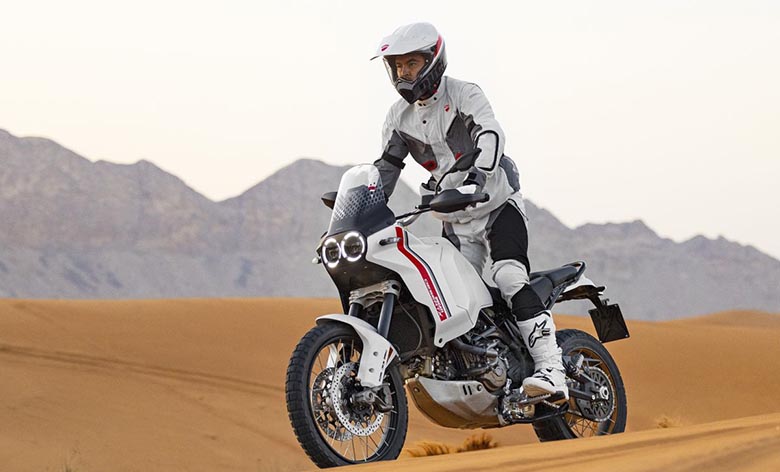
The WP Xplor fork and shock combination on the KTM is superior to the KYB units on the Ducati. This fork and shock, along with the 790 Adventure/890 Adventure itself, are the most excellent ADV suspension system on the market.
However, while the ride is rigid and taught compared to the Ducati’s softer base configuration, KTM’s Ready To Race slogan begins to come through. As a result, the Ducati is easier to handle on the tarmac.
The Ducati measures just 0.2 inches less than the BMW at 34.4 inches. Thus the seat heights are almost comparable between the two machines. The four-piston Brembo monobloc radially mounted calipers and off-road ABS have the same brakes. Additionally, the weights of the KTM and Ducati are 490 and 492 pounds, respectively, when fully fueled. The Ducati and KTM both have fuel capacities of 5.54 gallons and 5.3 gallons, respectively.
By building the motorcycle’s back to accommodate the company’s extra auxiliary gas tank, which boosts the motorcycle’s capacity to a vast 7.9 gallons, the same as the BMW R 1250 GS Adventure, Ducati has edged over KTM in the travel department.
The low center of gravity achieved by keeping the gasoline low ensures that the 890 has enough stability over rough terrain even as the fuel load steadily drops. It has long been one of KTM’s selling advantages. Ride over 890 R is a fantastic vehicle because of the weight distribution and great WP suspension with a bit of extra travel. The parallel-twin motor also performs this great.
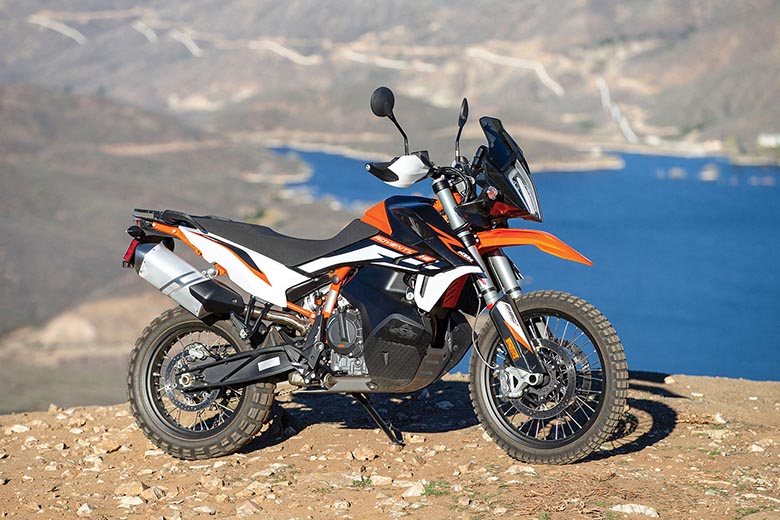
The 889cc, 100 horsepower KTM engine is one of the best motorcycle engines. With all the technology the Ducati has, it has more than adequate top-end for highway use and is smoother on the initial touch of the throttle compared to the Ducati while in full power mode. In full power mode, the Ducati’s 937cc L-twin still exhibits a slight hesitancy, but when it is dialed back for the dirt-level 75 horsepower, the throttle application is flawless.
Ducati, however, made a mistake with the electronics’ usability. The phone-style dash might be challenging to use and is more challenging to locate and alter the desired sections than the KTM. The KTM still had an advantage over the Ducati regarding electronics usability.
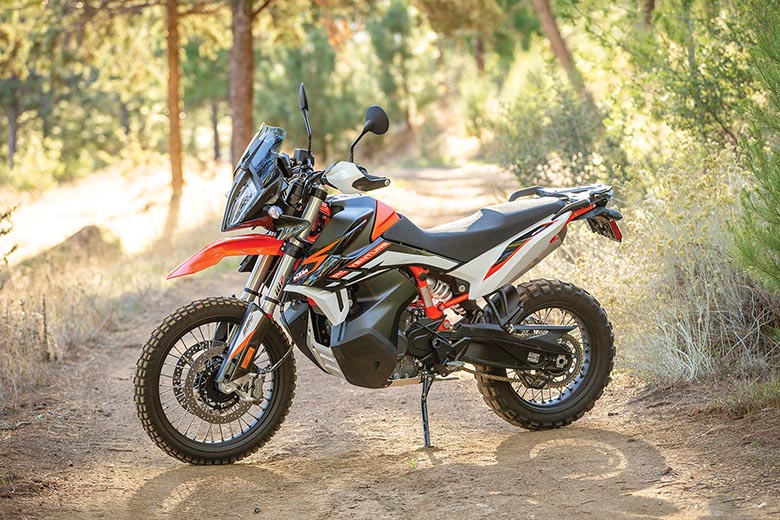
Which One Is Best?
Regardless of the price, the combination of a rangy ride position, superior stability due to the longer wheelbase than the KTM, that gorgeous engine (although not as lovely as the KTM), and the fact that you can carry a few more liters on the back makes for a compelling case. There is no denying that the KTM is a sharper tool than the Ducati.
A more aggressive rider might benefit from the sportier suspension configuration, low-slung fuel tank, and cramped cockpit. The middleweight ADV market represents a rider’s highly individual preferences, in contrast to the hyper naked bike class, where everything is so dang fast that it only really matters what color you like your bike.
DesertX Ducati vs 890 Adventure R KTM – Technical Comparison
| Specs \ Bikes | DesertX Ducati | 890 Adventure R KTM |
|---|
Engine
| Type | Ducati Testastretta 11°, L-Twin cylinders | Parallel twin |
| Valve train | Desmodromic valvetrain, eight valves | DOHC, eight valves |
| Displacement | 937cc | 889cc |
| Bore x Stroke | 94 x 67.5mm | 90.7 x 68.8mm |
| Horsepower | 110 hp | 100 hp |
| Torque | 68 ft-lb | 74 ft-lb |
| Cooling System | Liquid | Liquid |
| Fuel System | EFI Bosch, w/ 53mm throttle body | EFI Dell’orto w/ 46mm throttle body |
| Transmission | 6-speed | 6-Speed |
Chassis
| Frame | Tubular steel trellis | Chromoly Tubular steel trellis |
| Front Suspension | KYB 46mm fork, fully adjustable. | WP Xplor, fully adjustable |
| Rear Suspension | KYB shock, fully adjustable | WP Xplor, single shock, fully adjustable |
| Front-Wheel Travel | 9.06 in. | 9.4 in. |
| Rear-Wheel Travel | 8.66 in. | 9.4 in. |
| Front Brake | Radially mounted, 4-piston calipers, dual 320mm discs w/ cornering ABS | Radially mounted 4-piston calipers, dual 320mm discs w/ ABS |
| Rear Brake | Two pistons, fixed caliper, 265mm disc, w/ cornering ABS | 2-piston floating caliper, 260mm disc, w/ABS |
| Front Tire | Pirelli Scorpion Rally STR 90/90-21 in. | Continental TKC 90/90R-21 in. |
| Rear Tire | Pirelli Scorpion Rally STR 150/70-18 in. | Continental TKC 150/70R-18 in. |
Dimension
| Rake | 27.6° | 26.3/26.2° |
| Wheelbase | 63.3 in. | 60.2 in. |
| Seat Height | 34.4 in. | 34.6 in. |
| Fuel Capacity | 5.54 gal. | 5.3 gal. |
| Weight | 492 lbs. | 432 lbs. |

